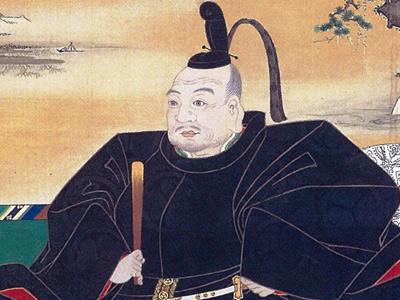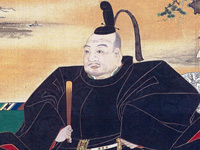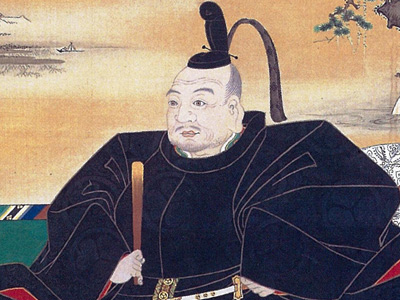Tokugawa Ieyasu (1543-1616)

Ieyasu and Hideyoshi (1584–1598)
In 1584, Ieyasu decided to support Oda Nobukatsu, the eldest surviving son and heir of Oda Nobunaga, against Hideyoshi. This was a dangerous act and could have resulted in the annihilation of the Tokugawa.
Tokugawa troops took the traditional Oda stronghold of Owari; Hideyoshi responded by sending an army into Owari. The Komaki Campaign was the only time any of the great unifiers of Japan fought each other. The campaign proved indecisive and after months of fruitless marches and feints, Hideyoshi settled the war through negotiation. First he made peace with Oda Nobukatsu, and then he offered a truce to Ieyasu. The deal was made at the end of the year; as part of the terms Ieyasu's second son, Ogimaru (also known as Yuki Hideyasu) became an adopted son of Hideyoshi.
Ieyasu's aide, Ishikawa Kazumasa, chose to join the pre-eminent daimyō and so he moved to Osaka to be with Hideyoshi. However, few other Tokugawa retainers followed this example.
Hideyoshi was understandably distrustful of Ieyasu, and five years passed before they fought as allies. The Tokugawa did not participate in Hideyoshi's successful invasions of Shikoku and Kyūshū.
In 1590, Hideyoshi attacked the last independent daimyō in Japan, Hōjō Ujimasa. The Hōjō clan ruled the eight provinces of the Kantō region in eastern Japan. Hideyoshi ordered them to submit to his authority and they refused. Ieyasu, though a friend and occasional ally of Ujimasa, joined his large force of 30,000 samurai with Hideyoshi's enormous army of some 160,000. Hideyoshi attacked several castles on the borders of the Hōjō clan with most of his army laying siege to the castle at Odawara. Hideyoshi's army captured Odawara after six months (oddly for the time period, deaths on both sides were few). During this siege, Hideyoshi offered Ieyasu a radical deal. He offered Ieyasu the eight Kantō provinces which they were about to take from the Hōjō in return for the five provinces that Ieyasu currently controlled (including Ieyasu's home province of Mikawa). Ieyasu accepted this proposal. Bowing to the overwhelming power of the Toyotomi army, the Hōjō accepted defeat, the top Hōjō leaders killed themselves and Ieyasu marched in and took control of their provinces, so ending the clan's reign of over 100 years.
Ieyasu now gave up control of his five provinces (Mikawa, Tōtōmi, Suruga, Shinano, and Kai) and moved all his soldiers and vassals to the Kantō region. He himself occupied the castle town of Edo in Kantō. This was possibly the riskiest move Ieyasu ever made—to leave his home province and rely on the uncertain loyalty of the formerly Hōjō samurai in Kantō. In the end, it worked out brilliantly for Ieyasu. He reformed the Kantō provinces, controlled and pacified the Hōjō samurai and improved the underlying economic infrastructure of the lands. Also, because Kantō was somewhat isolated from the rest of Japan, Ieyasu was able to maintain a unique level of autonomy from Hideyoshi's rule. Within a few years, Ieyasu had become the second most powerful daimyō in Japan. There is a Japanese proverb which likely refers to this event: "Ieyasu won the Empire by retreating."
In 1592, Hideyoshi invaded Korea as a prelude to his plan to attack China. The Tokugawa samurai never actually took part in this campaign, though in early 1593, Ieyasu himself was summoned to Hideyoshi's court in Nagoya (in Kyūshū, different from the similarly spelled city in Owari Province) as a military advisor and given command of a body of troops meant as reserves for the Korean campaign. He stayed in Nagoya off and on for the next five years. Despite his frequent absences, Ieyasu's sons, loyal retainers and vassals were able to control and improve Edo and the other new Tokugawa lands.
In 1593, Hideyoshi fathered a son and heir, Toyotomi Hideyori.
In 1598, with his health clearly failing, Hideyoshi called a meeting that would determine the Council of Five Elders, who would be responsible for ruling on behalf of his son after his death. The five that were chosen as regents (tairō) for Hideyori were Maeda Toshiie, Mōri Terumoto, Ukita Hideie, Uesugi Kagekatsu, and Ieyasu himself, who was the most powerful of the five. This change in the pre-Sekigahara power structure became pivotal as Ieyasu turned his attention towards Kansai; and at the same time, other ambitious (albeit ultimately unrealized) plans, such as the Tokugawa initiative establishing official relations with Mexico (New Spain at the time), continued to unfold and advance.
HISTORY

RESOURCES
This article uses material from the Wikipedia article "Tokugawa Ieyasu (1543-1616)", which is released under the Creative Commons Attribution-Share-Alike License 3.0.
© Stories Preschool. All Rights Reserved.










